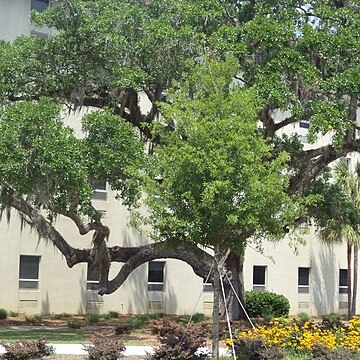Trees , deciduous, to 20 m. Bark light gray, tinged with red, with thick plates underlying scales. Twigs grayish or reddish, (2-)3(-4) mm diam., villous, soon glabrate. Buds 3 mm, gray-puberulent. Leaves: petiole 8-20(-25) mm. Leaf blade obovate or broadly obovate, 100-160(-200) × 50-100(-120) mm, base narrowly cuneate to acute, margins moderately to deeply lobed, lobes somewhat to sharply angular or spatulate, often with 2-3 teeth, sinuses nearly to midrib, secondary veins arched, divergent, (3-)5-7 on each side, apex broadly rounded or ovate; surfaces abaxially light green or somewhat glaucous, tomentose, tomentum persisting or soon falling, adaxially dark green or dull gray, sparsely puberulent to glabrate. Acorns 1-2 on axillary peduncles to 40 mm; cup goblet-shaped, burlike, or spheroid, 15-20 mm deep × 20-30 mm wide, usually completely enclosing nut or merely apex visible, rarely enclosing only 1/2 nut, orifice smaller than nut diameter, often splitting irregularly at maturity, scales closely appressed, especially about margin, laterally connate, broadly triangular, keeled-tuberculate, finely grayish tomentose; nut light brown or grayish, ovoid-ellipsoid or oblong, (15-)25-50 × (10-)20-40 mm, finely puberulent or floccose. Cotyledons distinct.
More
Tree to 30 m, with thick, gray bark, the twigs soon glabrescent; lvs narrowly obovate, densely gray-tomentose beneath with horizontally spreading, many-branched stellate hairs, above which project a few erect, few-branched hairs, or with only the latter type of hair; lateral lf-lobes 2–4 pairs, oval, rounded to subacute, rarely emarginate, the lower usually much smaller and separated from the upper by often elongate sinuses; acorns 1.5–2.5 cm, about as thick; cup covering half to all the conic-ovoid nut, the lower scales strongly concave. Wet woods and swamps on the coastal plain; s. N.J. to Fla. and Tex., n. in the interior to s. Ind., s. and w. Ill., and Mo.
A medium sized tree. It grows 18 m tall and spreads 9 m wide. It loses its leaves during the year. It has an open crown and large crooked branches. The leaves are oblong or egg shaped. They have deep, irregular lobes. They are dark green above and paler underneath. The fruit are acorns which are almost stalkless. They are 1.2-2.5 cm long and nearly round. They are almost enclosed by the cup.
Found on poorly drained, alluvial, clayey soils, most commonly on low lying flats in first bottoms and terraces of larger streams, also on edges and shallows of swamps, sloughs, and bayous; in poorly drained depressions or sink holes on ridges
More
It is a temperate plant. It grows up to about 150 m altitude in SE regions of the USA. It suits hardiness zones 8-10.


